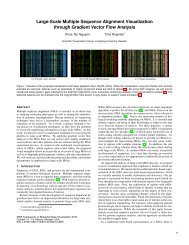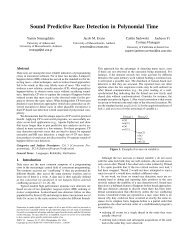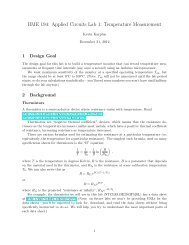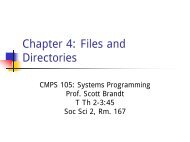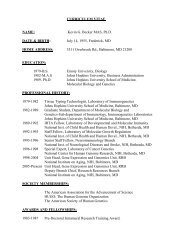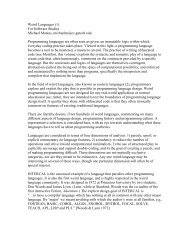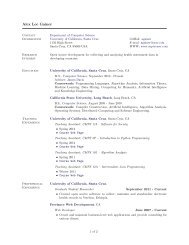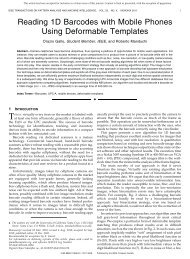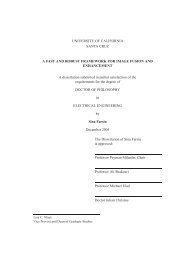Amoeba — A Distributed Operating System for the 1990s - CiteSeerX
Amoeba — A Distributed Operating System for the 1990s - CiteSeerX
Amoeba — A Distributed Operating System for the 1990s - CiteSeerX
You also want an ePaper? Increase the reach of your titles
YUMPU automatically turns print PDFs into web optimized ePapers that Google loves.
that allowed us to do process execution, migration, debugging and checkpointing in such a<br />
way that a very efficient implementation is possible.<br />
6 UNIX Emulation<br />
<strong>Amoeba</strong> is a new operating system with a system interface that is quite different from that of<br />
<strong>the</strong> popular operating systems of today. Since we had no intention of writing hundreds of utility<br />
programs <strong>for</strong> <strong>Amoeba</strong> from scratch, it was quickly decided to write a UNIX emulation package,<br />
to allow most UNIX utilities to work on <strong>Amoeba</strong>, sometimes with small changes. Binary<br />
compatibility was considered as a possibility, but was rejected <strong>for</strong> an initial emulation package<br />
on grounds that it is more complicated and less useful (first, one has to choose a very particular<br />
version of Unix; second, one usually has binaries <strong>for</strong> only one machine architecture, while<br />
sources can be compiled <strong>for</strong> any machine archtecture; and, third, binary emulation is bound<br />
to be slow). Experiments with binary emulation have, however, shown that it is quite feasible<br />
to provide it in <strong>the</strong> future.<br />
The emulation facility started out as a library of UNIX routines that have <strong>the</strong> standard UNIX<br />
interface and semantics, but do <strong>the</strong>ir work by calling <strong>the</strong> Bullet Server, <strong>the</strong> Directory Server<br />
and <strong>the</strong> <strong>Amoeba</strong> process management facilities. The system calls implemented initially were<br />
those <strong>for</strong> file I/O (open, close, dup, read, write, lseek) and a few of <strong>the</strong> ioctl calls <strong>for</strong> ttys. These<br />
were very easy to implement under <strong>Amoeba</strong> (about two week’s work) and were enough to get<br />
a surprising number of UNIX utilities to run.<br />
Subsequently, a Session server was developed to allocate UNIX PIDs, PPIDs, and assist in<br />
<strong>the</strong> handling of system calls involving <strong>the</strong>m (<strong>for</strong>k, exec, signal, kill). The Session Server is also<br />
used <strong>for</strong> dealing with UNIX pipes. With <strong>the</strong> help of <strong>the</strong> Session Server many o<strong>the</strong>r UNIX utilities<br />
are now usable on <strong>Amoeba</strong>.<br />
Currently, about 100 utilities have been made to run on <strong>Amoeba</strong> without any changes to<br />
<strong>the</strong> source code. The Bourne shell needed a two-line modification because of <strong>the</strong> extraordinary<br />
way it allocates memory. We have not attempted to port some of <strong>the</strong> more esoteric UNIX programs;<br />
In some cases, we cannot even determine what <strong>the</strong>y do. Work is in progress to make<br />
our UNIX interface compatible with <strong>the</strong> emerging standards (e.g., IEEE POSIX).<br />
The X window system has been ported to <strong>Amoeba</strong> and supports <strong>the</strong> use of both TCP/IP<br />
and <strong>Amoeba</strong> RPC, so that an X client on <strong>Amoeba</strong> can converse with an X server on <strong>Amoeba</strong><br />
and vice versa.<br />
We have found that <strong>the</strong> availability of <strong>the</strong> UNIX utilities has made <strong>the</strong> transition to <strong>Amoeba</strong><br />
much easier. Slowly, however, many of <strong>the</strong> UNIX utilities will be replaced by utilities that are<br />
better adapted to <strong>the</strong> <strong>Amoeba</strong> distributed environment. Our new parallel make is an obvious<br />
example.<br />
Why did we emulate UNIX in a library instead of making <strong>the</strong> system binary compatible?<br />
Because any system that is binary compatible with UNIX cannot be much of a step <strong>for</strong>ward<br />
beyond <strong>the</strong> ideas of <strong>the</strong> early 1970s. We wanted to design a new system from <strong>the</strong> ground up<br />
<strong>for</strong> <strong>the</strong> <strong>1990s</strong>. If <strong>the</strong> UNIX designers had constrained <strong>the</strong>mselves to be binary compatible with<br />
<strong>the</strong> <strong>the</strong>n-popular RT-11 operating system, it would not be now where it is.<br />
7 Conclusions<br />
BOZZA<br />
We are pleased with most of <strong>the</strong> design decisions of <strong>the</strong> <strong>Amoeba</strong> project. The decision, especially,<br />
to design a distributed operating system without attempting to restrict ourselves to<br />
existing operating systems or operating system interfaces has been a good one. UNIX is an excellent<br />
operating system, but it is not a distributed one and was not designed as such. We do<br />
not believe we would have made such a balanced design had we decided to build a distributed<br />
system with a UNIX interface.<br />
12




